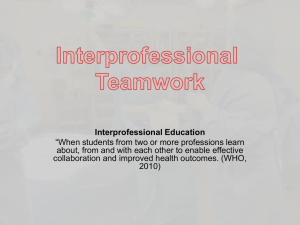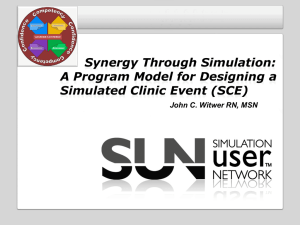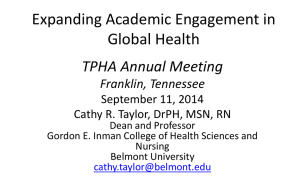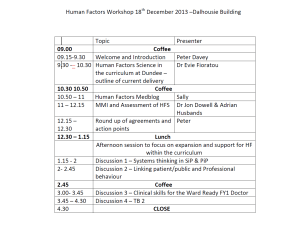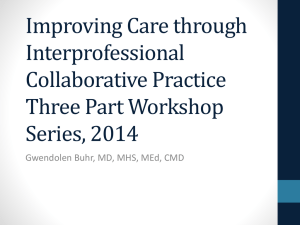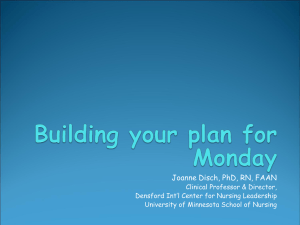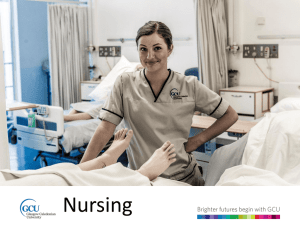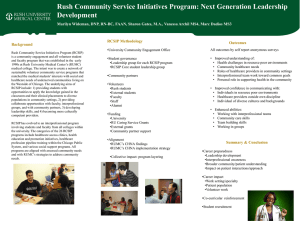Interprofessional Education - David Geffen School of Medicine at
advertisement
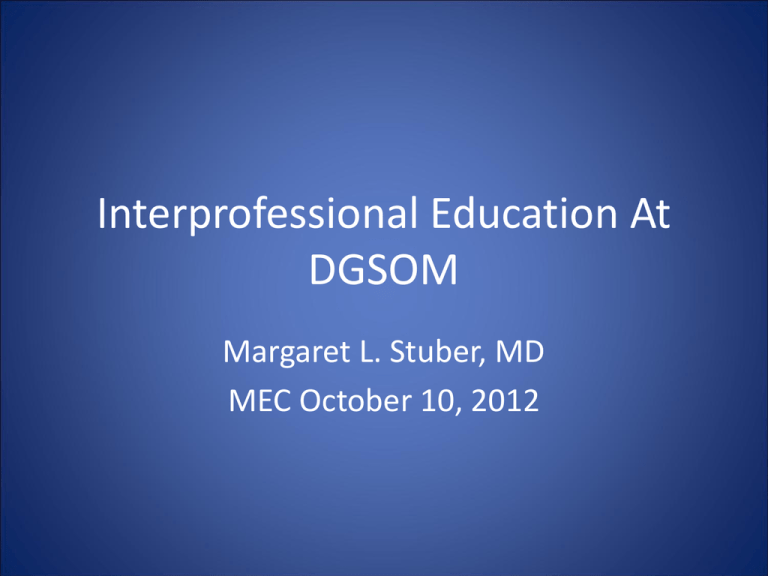
Interprofessional Education At DGSOM Margaret L. Stuber, MD MEC October 10, 2012 Not a new topic • Two World Health Organization reports in 1988, “Continuing education for Physicians” and “Learning Together to Work Together for Health”. • “Health Professionals learning from, with and about one another” • Thistlethwaite J. Med Educ 2012 46 (1) 58-70 Institute of Medicine report • 2001 Crossing the Quality Chasm: A New Health System for the 21st Century • “All health care professionals should be educated to deliver patient-centered care as members of an interdisciplinary team, emphasizing evidence-based practice, quality improvement approaches, and information.” Follow-up IOM report • Health Professions Education: A Bridge to Quality proposed core competencies for all clinicians, regardless of discipline, including “Work in interdisciplinary teams: cooperate, collaborate, communicate, and integrate care in teams to ensure that care is continuous and reliable.” Changing healthcare • Shortages and high cost of doctoral level providers • Training of new “mid-level” providers ( dental therapists, physician assistants) • Concept of a medical home • Move to HMO structure Changing accreditation standards • Medicine • Nursing • Dentistry Current impetus for the topic • 2011 publication of a pamphlet jointly by the national professional educational organizations of – – – – – – Dentistry Medicine (allopathic) Medicine (osteopathic) Nursing Pharmacy Public Health “Core competencies for Interprofessional Collaborative Practice” sponsored by the Interprofessional Education Collaborative. Proposed Competency Domains • Competency Domain 1: Values/Ethics for Interprofessional Practice • Competency Domain 2: Roles/ Responsibilities • Competency Domain 3: Interprofessional Communication • Competency Domain 4: Teams and Teamwork Values/Ethics for Interprofessional Practice • • • • • • • • • • Place the interests of patients and populations at the center of interprofessional health care delivery. Respect the dignity and privacy of patients while maintaining confidentiality in the delivery of team-based care. Embrace the cultural diversity and individual differences that characterize patients, populations, and the health care team. Respect the unique cultures, values, roles/responsibilities, and expertise of other health professions. Work in cooperation with those who receive care, those who provide care, and others who contribute to or support the delivery of prevention and health services. Develop a trusting relationship with patients, families, and other team members (CIHC, 2010). Demonstrate high standards of ethical conduct and quality of care in one’s contributions to team-based care. Manage ethical dilemmas specific to interprofessional patient/ population centered care situations. Act with honesty and integrity in relationships with patients, families, and other team members. Maintain competence in one’s own profession appropriate to scope of practice Roles/Responsibilities • • • • • • • • • Communicate one’s roles and responsibilities clearly to patients, families, and other professionals. Recognize one’s limitations in skills, knowledge, and abilities. Engage diverse healthcare professionals who complement one’s own professional expertise, as well as associated resources, to develop strategies to meet specific patient care needs. Explain the roles and responsibilities of other care providers and how the team works together to provide care. Use the full scope of knowledge, skills, and abilities of available health professionals and healthcare workers to provide care that is safe, timely, efficient, effective, and equitable. Communicate with team members to clarify each member’s responsibility in executing components of a treatment plan or public health intervention. Forge interdependent relationships with other professions to improve care and advance learning. Engage in continuous professional and interprofessional development to enhance team performance. Use unique and complementary abilities of all members of the team to optimize patient care. Interprofessional communication • • • • • • • • Choose effective communication tools and techniques, including information systems and communication technologies, to facilitate discussions and interactions that enhance team function. Organize and communicate information with patients, families, and healthcare team members in a form that is understandable, avoiding discipline-specific terminology when possible. Express one’s knowledge and opinions to team members involved in patient care with confidence, clarity, and respect, working to ensure common understanding of information and treatment and care decisions. Listen actively, and encourage ideas and opinions of other team members. Give timely, sensitive, instructive feedback to others about their performance on the team, responding respectfully as a team member to feedback from others. Use respectful language appropriate for a given difficult situation, crucial conversation, or interprofessional conflict. Recognize how one’s own uniqueness, including experience level, expertise, culture, power, and hierarchy within the healthcare team, contributes to effective communication, conflict resolution, and positive interprofessional working relationships (University of Toronto, 2008). Communicate consistently the importance of teamwork in patient-centered Teams and teamwork • • • • • • • • • • • Describe the process of team development and the roles and practices of effective teams. Develop consensus on the ethical principles to guide all aspects of patient care and team work. Engage other health professionals—appropriate to the specific care situation—in shared patient-centered problem-solving. Integrate the knowledge and experience of other professions— appropriate to the specific care situation—to inform care decisions, while respecting patient and community values and priorities/ preferences for care. Apply leadership practices that support collaborative practice and team effectiveness. Engage self and others to constructively manage disagreements about values, roles, goals, and actions that arise among healthcare professionals and with patients and families. Share accountability with other professions, patients, and communities for outcomes relevant to prevention and health care. Reflect on individual and team performance for individual, as well as team, performance improvement. Use process improvement strategies to increase the effectiveness of interprofessional teamwork and team-based care. Use available evidence to inform effective teamwork and team-based practices. Perform effectively on teams and in different team roles in a variety Modalities used • Service learning, such as in free clinics (University of Connecticut) • Practice learning, using simulation • (University of Washington) • Case studies and team-based learning (Jefferson Health Mentors program) • Ongoing small group seminar • (DGSOM at UCLA) What have we done at UCLA? • 2007-2008: Leadership meetings of the schools of nursing and medicine • 2009: Pilot with two nursing faculty and a few advanced practice nursing students as elective • 2010: Required participation of one class (20) of advanced practice nursing students • 2011: Elective participation of 9 advanced practice nursing students This year • All (28) second year acute care nursing students are required to participate in three quarters of small-group Systems Based Healthcare class • Six School of Nursing faculty serve as small group tutors for the course Structure of the course • Meets for 3 hours on Tuesday or Thursday morning • Sessions are once or twice a month, September through June • Small groups are made of 7 to 9 students and two tutors • Tutors are from different disciplines, including medicine, nursing, psychology and social work Content of the course • Focus is on topics which are encountered in a clinical setting but often not discussed • Fulfill numerous graduation requirements • Examples – Medical error – Conflict of interest – Bias and assumptions – Death and dying Process of course • Students each are assigned an article to read and report on for the group • Students each write a reflection on the topic of the week and share this with the group • One of the students facilitates the group • Discussion, including polite disagreement, is encouraged • Students also use group for a home base Obstacles • SON and SOM are on different calendars, including start dates, vacations, and end dates • Evaluation systems are on different platforms • This is part-time school for nursing students, full-time for medical students • Nursing students often live very far away Discoveries • Medical students and faculty did not know what advanced practice nurses did, how they were trained, or their scope of practice • Medical students felt uneasy about roles and boundaries, such as between nurse anesthetist and anesthesiologist • Nursing students were surprised that medical students could be nice and not arrogant Modifications • Need to be clear that this is learning for both groups, not just for medical students to learn from nursing students • Emphasize the commonalities, such as being under constant scrutiny and feeling incompetent after having been competent • Address age and experience differences • Emphasize the developmental stage of taking on a new role and responsibility Plans • Try to see if this types of year-long interaction changes behavior on the wards using observation and 360 degree evaluation • Use a simulation to test out how they respond to work within a team • Develop new instruments, e.g. Intrinsic Association Test What might be done in dentistry? • Could coordinate with schools of public health, nursing, medicine ( no pharmacy or PA school s at UCLA) • Could do service learning together • Could do simulations together • Could participate in seminars • Could coordinate a day on integrated care • Connecting Dental Education to Other Health Professions Michael C. Alfano, D.M.D., Ph.D., J of Dental Education, 2012 Questions?
